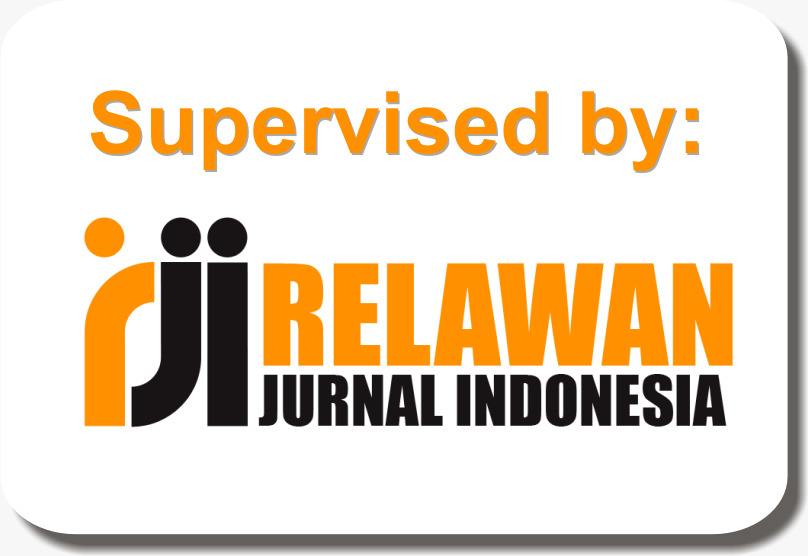IMPLEMENTATION OF AREFI TO IMPROVE BASIC KNOWLEDGE OF EFI
Abstract
Keywords
Full Text:
PDFReferences
N. Widodo, ÔÇťPengaruh Penggunaan Diagnosis Chart Terhadap Hasil Belajar Matakuliah Praktik Diagnosis Sistem Kelistrikan,ÔÇŁ J. Pendidik. Teknol. dan Kejuru., vol. 21, no. 2, pp. 130ÔÇô139, 2012.
Azharudin, A. R. Susantiq, and U. Firdaus, ÔÇťMedia Pemograman Python Berbasis Android,ÔÇŁ Karimah Tauhid, vol. 3, no. 4, pp. 4203ÔÇô4208, 2024, doi: 10.30997/karimahtauhid.v3i4.12767.
S. D. Maharani and S. S. E. Dewie, ÔÇťAnalisis Kebutuhan Media Augmanted Reality Pada Peserta Didik Kelas V Sd Plus Igm Palembang,ÔÇŁ Inov. Sekol. Dasar J. Kaji. Pengemb. Pendidik., vol. 10, no. 1, pp. 34ÔÇô45, 2023, doi: 10.36706/jisd.v10i1.21363.
R. Rizal, D. Rusdiana, W. Setiawan, and P. Siahaan, ÔÇťStudents perception of learning management system supported smartphone: Satisfaction analysis in online physics learning,ÔÇŁ J. Pendidik. IPA Indones., vol. 9, no. 4, pp. 600ÔÇô610, 2020, doi: 10.15294/jpii.v9i4.25363.
J. V.D. Wirjawan, D. Pratama, E. Pratidhina, A. Wijaya, B. Untung, and Herwinarso, ÔÇťDevelopment of smartphone app as media to learn impulse-momentum topics for high school students,ÔÇŁ Int. J. Instr., vol. 13, no. 3, pp. 17ÔÇô30, 2020, doi: 10.29333/iji.2020.1332a.
E. Risdianto, ÔÇťDevelopment of Blended Learning based on Web and Augmented Reality,ÔÇŁ vol. 295, no. ICETeP 2018, pp. 144ÔÇô147, 2019, doi: 10.2991/icetep-18.2019.35.
R. D. Kurniawan and R. Hidayah, ÔÇťValidity of Kimi Kimo Adventure Game Based on Android as Learning Media in Chemical Bonds BT - Proceedings of the International Joint Conference on Science and Engineering 2021 (IJCSE 2021),ÔÇŁ Proc. Int. Jt. Conf. Sci. Eng. 2021, vol. 209, no. Ijcse, pp. 247ÔÇô253, 2021.
J. S. Akbar and D. Djakariah, ÔÇťEffektifitas Penggunaan Media Pembelajaran Berbasis Augmented Reality Dalam Pembelajaran Kimia Di Era Society 5.0,ÔÇŁ UNESA J. Chem. Educ., vol. 13, no. 2, pp. 86ÔÇô99, 2024, doi: 10.26740/ujced.v13n2.p86-99.
A. Salsabila and A. K. Putra, ÔÇťVisualisasi Proses Vulkanisme melalui Media Pembelajaran Animasi berbasis Augmented Reality sebagai Media Digital Geografi,ÔÇŁ Cetta J. Ilmu Pendidik., no. June, 2024, doi: 10.37329/cetta.v7i2.3296.
F. Huda Aminuddin and T. Djauhari, ÔÇťDevelopment of 3D Augmanted Reality Teaching Materials Based on Virtual Technology As Learning Media,ÔÇŁ Dinasti Int. J. Educ. Manag. Soc. Sci., vol. 2, no. 5, pp. 763ÔÇô776, 2021, doi: 10.31933/dijemss.v2i5.880.
T. P. Socrates and F. Mufit, ÔÇťEfektivitas Penerapan Media Pembelajaran Fisika Berbasis Augmented Reality: Studi Literatur,ÔÇŁ EduFisika J. Pendidik. Fis., vol. 7, no. 1, pp. 96ÔÇô101, 2022, doi: 10.59052/edufisika.v7i1.19219.
A. Gunawan and A. R. Moh, ÔÇťMedia Pembelajaran Bidang Otomotif Menggunakan Augmanted Reality Berbasis Android Pada SMK Muhammadiyah 2 Wedi,ÔÇŁ Indones. J. Comput. Sci., vol. 12, no. 2, pp. 284ÔÇô301, 2023, [Online]. Available: http://ijcs.stmikindonesia.ac.id/ijcs/index.php/ijcs/article/view/3135
A. Fauzan Dianta, C. Devi, W. Sarinastiti, and Z. F. Akbar, ÔÇťMedia Pembelajaran Interaktif Berbasis Virtual Reality Menggunakan Video 360┬░,ÔÇŁ POSITIF J. Sist. dan Teknol. Inf., vol. 9, no. 1, pp. 21ÔÇô28, 2023, doi: 10.31961/positif.v9i1.1560.
A. A. Hidayat, A. Sutedi, and E. Gunadhi, ÔÇťMedia Pembelajaran Aksara Sunda Menggunakan Augmented Reality Berbasis Android,ÔÇŁ J. Algoritm., vol. 19, no. 2, pp. 505ÔÇô514, 2022, doi: 10.33364/algoritma/v.19-2.1135.
Nurslama Br Siregar and Siti Aliyah, ÔÇťImplementasi Media Pembelajaran Sholat Sunah Menggunakan Augmented Reality Berbasis Android,ÔÇŁ J. Ilm. Tek. Inform. dan Komun., vol. 3, no. 1, pp. 32ÔÇô45, 2023, doi: 10.55606/juitik.v3i1.372.
A. Bashri, R. P. P. Puspitawati, and M. S. P. Prastiwi, ÔÇťImplementasi Media Pembelajaran Berbasis Augmented Reality,ÔÇŁ J. ABDI Media Pengabdi. Kpd. Masy., vol. 7, no. 2, pp. 212ÔÇô217, 2022, doi: 10.26740/abdi.v7i2.17111.
R. F. Ekapti and M. M. Mokhtar, ÔÇťPersepsi Mahasiswa Indonesia dan Malaysia tentang Penerapan Augmented Reality pada Pembelajaran: Studi Pendahuluan,ÔÇŁ J. Tadris IPA Indones., vol. 3, no. 3, pp. 327ÔÇô335, 2023, doi: 10.21154/jtii.v3i3.2610.
I. K. M. Putra, N. L. P. N. S. P. Astawa, and I. P. Satwika, Media Pembelajaran berbasis Augmented Reality ÔÇťPRIARMIKA,ÔÇŁ vol. 4, no. 2. 2020. doi: 10.22437/jiituj.v4i2.11600.
Komarudin, I. M. Nauri, E. K. Mindarta, and S. R. Ariyanto, ÔÇťThe Effect of Augmented Reality-Based Automatic Transmission Media on Basic Knowledge,ÔÇŁ J. Ilm. Penelit. dan Pembelajaran Inform., vol. 9, no. 4, pp. 2418ÔÇô2425, 2024.
K. B. Nasution, W. Novitasari, Y. A. Siregar, N. Sahara, and L. Agustina, ÔÇťThe Effect Of Application-Based Augmented Reality Technology As Learning Media On The Learning Outcomes Of Man 1 Padangsidimpuan Plus Riset,ÔÇŁ Indo-MathEdu Intellectuals J., vol. 6, no. 1, pp. 465ÔÇô470, 2025.
S. T. Stefani and S. I. Haryudo, ÔÇťPengembangan Media Pembelajaran Interaktif Berbasis Problem Based Learning,ÔÇŁ J. Vocat. Tech. Educ., vol. 5, no. 2, pp. 193ÔÇô200, 2023, doi: 10.26740/jvte.v5n2.p193-200.
M. R. Pratiwi and N. Aulia, ÔÇťPengembangan Media Pembelajaran Permainan Monopoli Berbasis Student Teams Achievment Division Di Sekolah Dasar Negeri 015 / Ix Desa Kebon Ix,ÔÇŁ J. Ilm. Kaji. Multidisipliner, vol. 9, no. 3, pp. 150ÔÇô165, 2025.
R. Safitri, N. Setianti, and K. Kunci, ÔÇťRancang Bangun Aplikasi Pembelajaran Akuntasi Berbasis Android dengan Metode Agile,ÔÇŁ J. Inf. Syst. Manag., vol. 6, no. 1, 2024.
D. Govindarajan, T. S. Karthikeyan, G. Arsadh, and M. K. Muthulakshmi, ÔÇťSmart Location Navigator Using Augmented Reality,ÔÇŁ Int. Res. J. Adv. Eng. Hub, vol. 03, no. February, pp. 218ÔÇô223, 2025.
DOI: https://doi.org/10.29100/jipi.v10i3.8559
Refbacks
- There are currently no refbacks.

This work is licensed under a Creative Commons Attribution-ShareAlike 4.0 International License.
Website :áhttps://jurnal.stkippgritulungagung.ac.id/index.php/jipi/index
Emailá: jipi@stkippgritulungagung.ac.id

This work is licensed under a Creative Commons Attribution-ShareAlike 4.0 International License.




